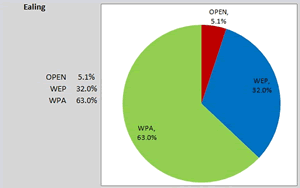Is Your WiFi Open to Attack?
Figures show 37% of households in Ealing are at risk from cybercriminals
New research by the online identity experts, Garlik, has found that a third of households in the capital are at risk from cybercriminals thanks to poor or no security settings on their home WiFi networks.
Ealing Borough came off slightly worse than average with over 37% of households failing to secure their WiFi network adequately. (See pie chart, right)
The research, carried out by Garlik over a two week period, across 13 different boroughs and 11,000 households in Greater London found that: -
• Nearly five per cent (100,000) of households had no security at all, leaving their home WiFi networks completely open to criminals.
• Almost thirty per cent had extremely weak WiFi security settings, known as WEP that can be cracked within minutes.
• Only sixty five per cent of households were found to have the most secure setting for their home WiFi networks, known as WPA.
“Using weak WiFi security like WEP is the digital equivalent of locking your front door but with a sign saying ‘the key is under the mat, help yourselves,” commented Tom Ilube, CEO of Garlik.
“With the recent introduction of the Digital Economy Act people need to be aware that they could face a fine, the risk of disconnection or indeed risk falling victim to cybercrime if they do not take WiFi security seriously.”
If a cybercriminal gains access to someone’s home WiFi, either due to the network being unsecure or a network password being cracked, then email accounts, social networking sites and even online banking can be broken in to. Also with access to someone’s home WiFi, a cybercriminal can use the internet connection however they choose. The home owner may be completely unaware as the hacker browses obscene websites or illegally downloads copyrighted music, films or TV shows from their home network. The Digital Economy Act now gives copyright owners the power to demand that Internet Service Providers (ISPs) take action against suspected filesharers. Even if these offences have occurred without the home owners permission or knowledge they will still be held accountable, risking the possibility of fines or even disconnection.
“We strongly encourage people to upgrade their wireless routers from the weak WEP security setting to the much stronger WPA (ideally WPA2) settings and for those with no security settings to wise up to the potential risks they are exposing themselves to,” added Ilube.
Steps to securing your home WiFi: -
• Set your router to the highest security setting possible. Ideally WPA2. If your router will only support WEP, contact your ISP provider and ask them to upgrade your router. If you are unsure how to change your security setting your ISP can help with this too.
• Ensure the password for your home network is not obvious or weak (e.g. cat, dog). Use a complex mixture of letters, numbers and special characters such as *, @, !.
• Also ensure your router password is changed from the default setting when it was first installed. Often people are unaware that almost all routers are sent out to homes with exactly the same, widely known password and login details.
April 28, 2010
Related links
|
